

Tragedy of the commons. The tragedy of the commons concept is often cited in connection with sustainable development, meshing economic growth and environmental protection, as well as in the debate over global warming.

It has also been used in analyzing behavior in the fields of economics, evolutionary psychology, anthropology, game theory, politics, taxation, and sociology. However the concept, as originally developed, has also received criticism for not taking into account the many other factors operating to enforce or agree on regulation in this scenario. Lloyd's pamphlet[edit] In 1833, the English economist William Forster Lloyd published a pamphlet which included an example of herders sharing a common parcel of land on which they are each entitled to let their cows graze. In English villages, shepherds had sometimes grazed their sheep in common areas, and sheep ate grass more severely than cows.
Garrett Hardin's article[edit] [edit] Anthropology, Economics, and Choice by Michael Chibnik. Austin: University of Texas Press, 2011. - Wilk - 2013 - Anthropology of Work Review. Michael Chibnik: Books, Biography, Blog, Audiobooks, Kindle. College of Liberal Arts & Sciences. Choice. Choice consists of a mental decision, of judging the merits of multiple options and selecting one or more of them.
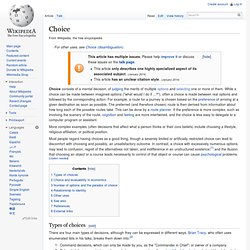
While a choice can be made between imagined options ("what would I do if ...? "), often a choice is made between real options and followed by the corresponding action. For example, a route for a journey is chosen based on the preference of arriving at a given destination as soon as possible. The preferred (and therefore chosen) route is then derived from information about how long each of the possible routes take. This can be done by a route planner. More complex examples (often decisions that affect what a person thinks or their core beliefs) include choosing a lifestyle, religious affiliation, or political position. Most people regard having choices as a good thing, though a severely limited or artificially restricted choice can lead to discomfort with choosing and possibly, an unsatisfactory outcome.
Types of choices[edit] RationalIntuitiveRecognition basedCombination. Utility. Economic definitions[edit]
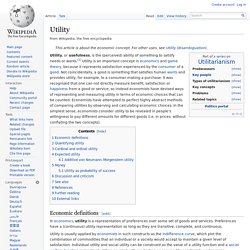
Belize. Belize ( i/bəˈliːz/) is a country on the eastern coast of Central America.
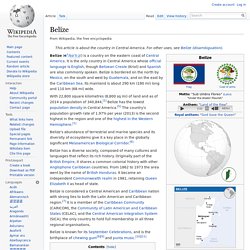
It is the only country in Central America whose official language is English, though Belizean Creole (Kriol) and Spanish are also commonly spoken. Belize is bordered on the north by Mexico, on the south and west by Guatemala, and on the east by the Caribbean Sea. Its mainland is about 290 km (180 mi) long and 110 km (68 mi) wide. With 22,800 square kilometres (8,800 sq mi) of land and as of 2014[update] a population of 340,844,[1] Belize has the lowest population density in Central America.[5] The country's population growth rate of 1.97% per year (2013) is the second highest in the region and one of the highest in the Western Hemisphere.[1] Belize's abundance of terrestrial and marine species and its diversity of ecosystems give it a key place in the globally significant Mesoamerican Biological Corridor.[6]
Oaxaca. Oaxaca (English /wəˈhɑːkə/ wə-HAH-kə, Spanish: [waˈxaka] ( ), from Nahuatl: Huaxyacac [waːsʃakak]), officially Free and Sovereign State of Oaxaca (Spanish: Estado Libre y Soberano de Oaxaca), is one of the 31 states which, along with the Federal District, make up the 32 federative entities of Mexico.
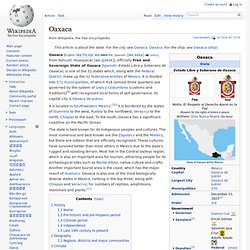
It is divided into 571 municipalities; of which 418 (almost three quarters) are governed by the system of Usos y costumbres (customs and traditions)[9] with recognized local forms of self governance. Its capital city is Oaxaca de Juárez. Peru. Peru i/pəˈruː/ (Spanish: Perú; Quechua: Piruw;[5] Aymara: Piruw), officially the Republic of Peru (Spanish: República del Perú, pronounced: [reˈpuβlika ðel peˈɾu]), is a country in western South America.
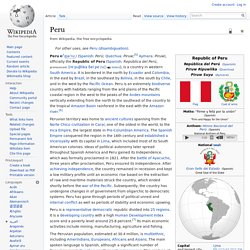
It is bordered in the north by Ecuador and Colombia, in the east by Brazil, in the southeast by Bolivia, in the south by Chile, and in the west by the Pacific Ocean. OWL: Book Review. Summary: This resource discusses book reviews and how to write them.
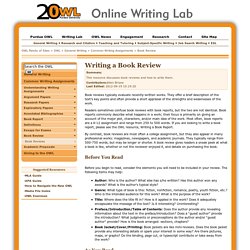
Contributors:Allen BrizeeLast Edited: 2012-09-19 10:19:20 Book reviews typically evaluate recently-written works. They offer a brief description of the text’s key points and often provide a short appraisal of the strengths and weaknesses of the work. Readers sometimes confuse book reviews with book reports, but the two are not identical. How to Write a Book Review. A book review is a description, critical analysis, and an evaluation on the quality, meaning, and significance of a book, not a retelling.
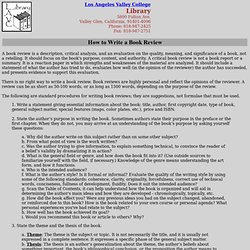
It should focus on the book's purpose, content, and authority. A critical book review is not a book report or a summary. It is a reaction paper in which strengths and weaknesses of the material are analyzed. It should include a statement of what the author has tried to do, evaluates how well (in the opinion of the reviewer) the author has succeeded, and presents evidence to support this evaluation.
There is no right way to write a book review. The following are standard procedures for writing book reviews; they are suggestions, not formulae that must be used. 1. A. 3. A. Example Title: We Had it Made General Subject Matter: Religious Intolerance Theme: The effects of religious intolerance on a small town Thesis: Religious intolerance, a sickness of individuals, contaminates an entire social group 4. A. 5. 9. Character Theme Plot Style Setting Biography.